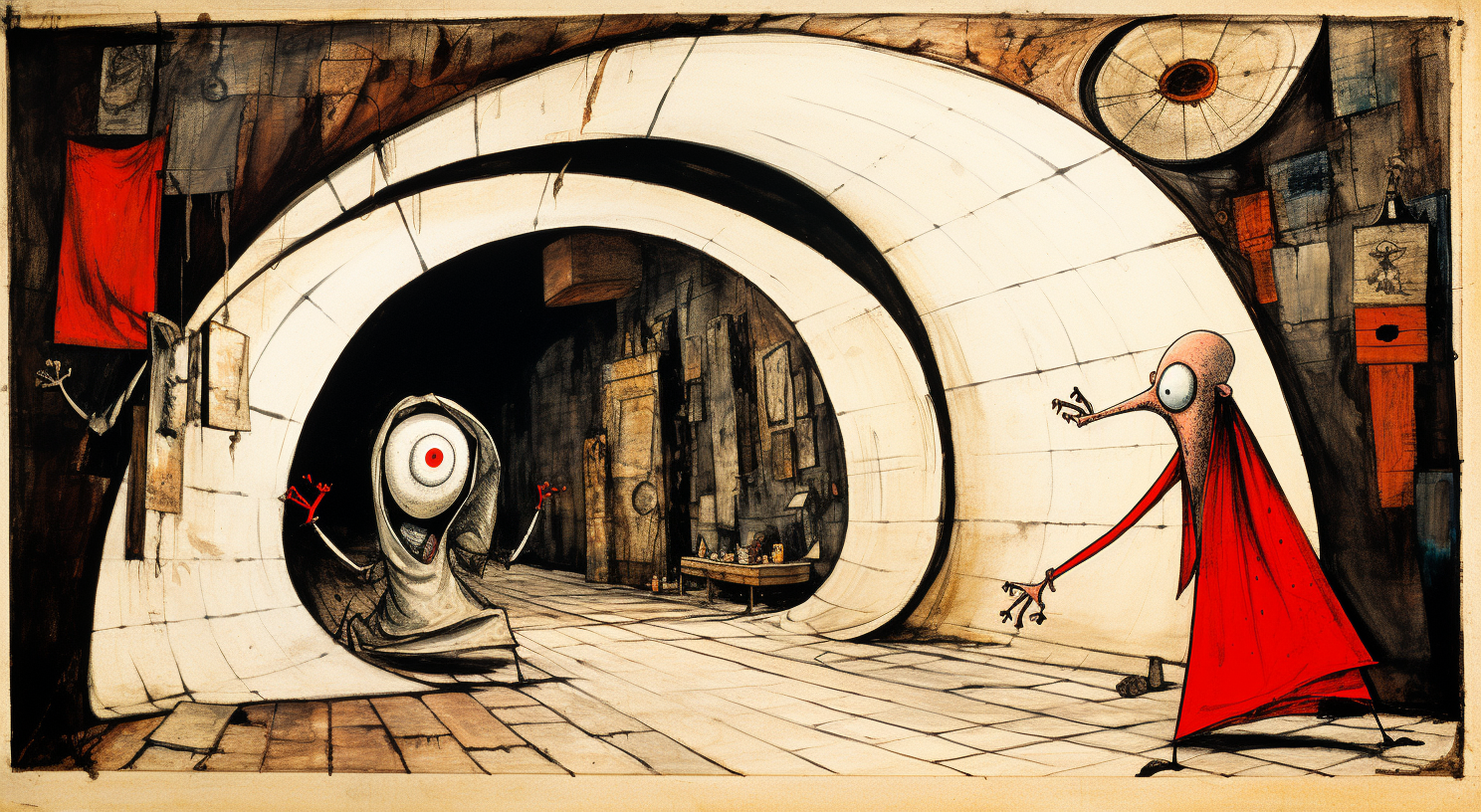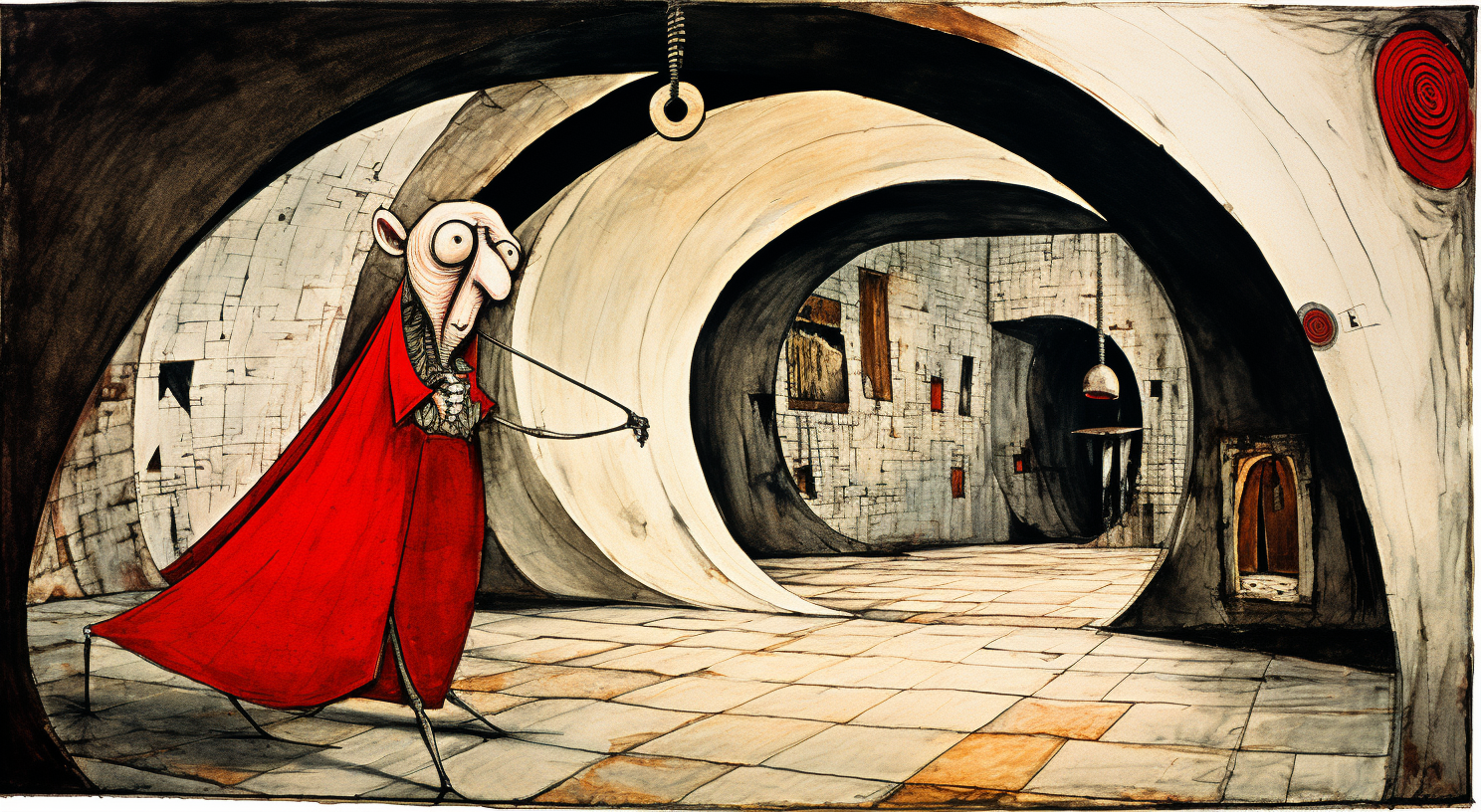4.1 On session one

Some things that happen here for the first time reoccur in the subsequent sessions. Due to that, the description of the first session is a bit wordier than the other two.
That applies to the speed I sunk into the trip. You look back 15–20 minutes after the injection and suddenly realize this whole thing has been going on for 15–20 minutes already. You fall in transparently and with no warning. Here and after, all the timestamps are not precise.
“K-hole,” the pop-culture cliché attached to ketamine, looks like this: it's as if you're riding a metro train, and you're the driver, black-grey-ish space with pale ornamentation flies right into your face. Face you stopped feeling 20 minutes ago.
To be honest, I'm still not sure I went through the K-hole. What I experienced fits the description, but I did not find this effect so profound to merit its status in psychedelic folklore. Perhaps, it's a very distinct feature of ketamine. And perhaps it's just one of those things that impress other people way more than it does me. It's the same with theater and Star Wars.
But this was the start for all of the three sessions.
Music
Most psychoactive substances, in one way or the other, enhance the way you hear music. It becomes more saturated; details and textures become richer and more pronounced. Sometimes you can even “touch” the music. It's not the case with ketamine.
Music becomes a bit pale and significantly loses its entertainment value; it becomes less music. But if you relax and let it be more than just an auditory experience for a short time, it becomes a fabric of all your experiences.
It's rather boring to listen to but exciting to live through. You're riding a roller coaster, and the world hums and buzzes.
Medication landscape
The second hour feels like looking at how the medication works through the machinery of your body.
When we have a headache, we swallow a pill, and the headache stops in 20–30 minutes. It's a simple timeline with 3 points: ache, pill, relief. What happens between points 2 and 3 is not accessible to us; frankly, we're not very interested in it. But it's obvious a lot is going on there.
The muscles of your neck and throat send the pill into your gut. The digestive and cardiovascular systems distribute the active chemical inside the body. Electric signals that pain is no more run along your neurons. I mean, if you look closely, these few minutes are more eventful than all the comic book lines of Marvel, DC, and Dark Horse combined.
And I was allowed to peek. Unfortunately, this whole thing is so complicated, alien, and indifferent that though curious, you still feel as if you were not invited to the party. It's like you're looking at a highly complex assembly line, and there's no way to make heads or tails of it and recognize the exact step you're looking at.
Ego dissolution
By the way, I'm rather frivolous in my use of first-person perspective. It's not always present.
First, let's accept as a given there were moments of I being wholly unconscious, and while the process was going on, no one was there to observe it and add to the sum of memories.
Second, the bits I can describe aren't something I can fully appropriate. Some things were happening, but the points of view of the observer, the observable, and something else that saw the connection between the former two were blended entirely. Father, Son, and the Holy Spirit, no less.
It feels like a loss of dualistic thinking, something associated with deep states of meditation. All the contents of your consciousness level onto a flat field. Nothing is more important than any other thing. Everything's equal, subject/object hierarchy is nowhere to be found, complete “one without a second” moment. That’s a concept people have dug through for hundreds of years and via thousands of books, so I'll put a link to Wikipedia and will leave it at that.
Next, the field shatters into microscopic particles of perception. These are not pixels, frames, or strings but something from which the veil of Maya is woven. They scatter around, and you, I, am simultaneously all and every one of these particles. Each of them sees the others and, reciprocally, is being seen by them. Biblically accurate consciousness if thou will.
Obviously, Buddhists have all the proper words for these things, but I’ll not go there now too.
I concur that nothing of the above makes sense for the regular mode of perception. And that's one of the issues. At some point, a thought occurs: “There's a chance this is a more fundamental level of reality than the one you're used to operating in.” Next to this thought, an unpleasant sensation arises; if that's the case, and there's no way to map it to everyday life, then it's nearly impossible to take your life seriously; it's so “not real.”
And that's a question of framing, of course, you have two ways out of it: nihilistic or constructive.
A familiar one-two punches you in the face at this moment:
— Have I gone completely nuts?
— Say, you have. So what?
More trivial matters
The therapist sits nearby throughout the whole thing and scratches something on his clipboard. I learned it a bit later, during the phases that are way easier to connect to the regular state of consciousness.
Like the tactile phase: when it's fun to squish the pillow and touch my own hands. Those atoms of perception start to lump back together. In a very impressionistic fashion at first: somewhere here is the area with the door to the bathroom, and somewhere there is the area where my therapist sits in the armchair (because of the blur, it seems like he's dancing while seated there).
Some details and plots reemerge, like a recurring plot of me dying while I'm in Czechia and all the adventures that would follow for my parents in case that happens.
The moment of full return gives “I know kung-fu” vibes from The Matrix. The first couple of hours, you don’t really care about the mundane everyday reality. You just have experienced EVERYTHING.
Immediately after
What happens next is basically waking up from anesthesia: the taste of paper in dry mouth, tiredness, and a light dizziness.
For me, the end was a lot about the physical pain. One that constantly annoys me surfaced a little more. It didn't get more acute, but it did get somewhat more accessible. It became easier to spot it and see its shape and understand what lying positions are more comfortable and where to point with my finger if I'd get to a masseuse. (To cool down the drama, I don't have any draining chronic pain I'd have to manage with pills or anything like that, but some places can benefit from extra care).
It's hard to imagine a more obvious signal that my body demands attention. Considering that for the last 18 months, I was pretty consistent with my fitness routine, okay nutrition, and regulare sleep, this demand from my body pissed me off quite a bit. The fuck else do you need?
Me and my body did not find mutual understanding later that evening too. I came home, ate dinner, and marched to the bathroom to puke. That was kind of a micro-experience in itself; I was very resigned and dispassionate about it. “Well, gotta do what I gotta do, ok.”
Next day was the integration session, the discussion of images and themes, and the first attempts to map the experience to “normal life.” With a bonus of utter bemusement on my therapist's face, “Seafood and noodles after a day like this, who does that?”
Next ↓


